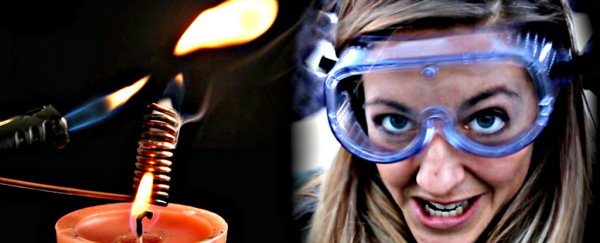We all know how to blow out a candle, but why do that, when you can learn so much about physics by getting a little creative with your flame-extinguishing methods? As Physics Girl shows us in her latest video, there are a whole heap of experiments you can do with a candle to show off the power of fluid dynamics, invisible chemistry, and, yes, even liquid nitrogen. Here are four methods you can try at home, and one bonus one that might be safer to leave to the professionals.
Let's start with a simple candle-snuffing method - a copper coil. If you've seen one of these used before, you'll know you simply have to place a copper coil over a flame, and it'll go out… right? Actually, even though the flame disappears and the candle starts to smoke, as soon as you lift the coil off, the candle starts burning again.
So what's going on here? As Diana explains, the design of the coil lets you rob the flame of a little bit of oxygen and heat - two things it needs to stay alight - but not quite enough to put the candle out.
Okay, so far so easy, but have you ever tried to blow out a candle behind an obstacle, like a glass or a box? As you can see in the video, depending on the shape of the object blocking the candle, the flow of air can alter drastically, and it'll affect whether or not you can put out your flame. It's all thanks to fluid dynamics, and this is one we highly recommend you try yourself.
But things get really interesting when Diana starts to play with dry ice, which looks really cool when it's poured over a candle to put it out. But even if you don't have access to dry ice, you can actually try this at home by making your own carbon dioxide - all you need is vinegar, baking soda, and two glasses.
We don't want to spoil what happens next, but let's just say it looks like you're pouring a whole lot of nothing out of a glass and magically extinguishing a flame. Hello, new favourite party trick.
Watch the video above to find out more, and to see what happens if you put a candle out with liquid nitrogen. And hopefully we don't have to tell you this, but don't forget to use safety googles and gloves if you're going to try this at home!
